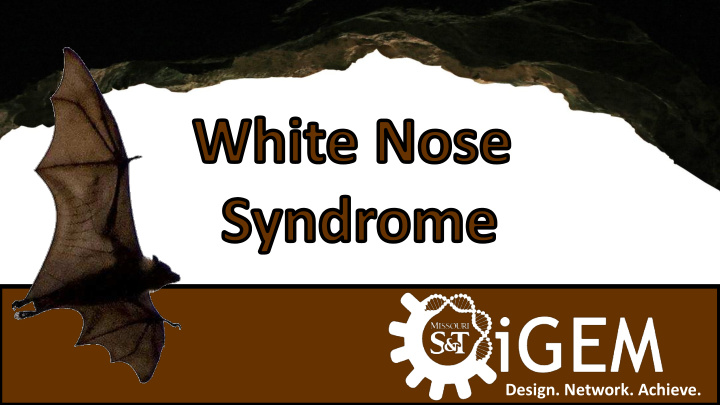



Design. Network. Achieve.
Background History of White Nose Syndrome and Science behind P. destructans Photo by: Minnesota Wildlife Control Design. Network. Achieve.
White Nose Syndrome • Originated in Eurasia • First seen in the US in 2006 • Defined in 2007 • Began in New York • Confirmed in Missouri in early 2012 • Caused by Pseudogymnoascus destructans Photo by: US Fish and Wildlife Services Missouri University of Science and Technology
Missouri, especially in the Rolla area, has been greatly affected by WNS Missouri University of Science and Technology
P. . destructans • Confirmed sole cause of WNS • Deadly effect only in bats • Bat to Bat transmission confirmed • Cave to cave transmission by humans unconfirmed Photo by: US Forest Service Missouri University of Science and Technology
Effects on Bats • Ear, wing, and nose invasion • Disruption of hibernation • Insufficient fat storage • Surviving bats can clear infection, if they make it to spring Photo by: Nancy Heaslip Missouri University of Science and Technology
Photo by: Jonathan Reichard – Boston University Missouri University of Science and Technology
Death Toll • Proved fatal in 6 species of bats • >7 million bats have died • 90-100% mortality rate Photo by: Al Hicks Missouri University of Science and Technology
Our Proje ject Helping Bats Survive Winter Photo by: Minnesota Wildlife Control Design. Network. Achieve.
Project Overv rview • Health threat only during hibernation • Bats’ immune system can clear infection • VOCs can slow fungal growth Missouri University of Science and Technology
Objectives • Produce ocimene in E. coli • Introduce high-throughput mevalonate pathway into E. coli • Determine production/expression levels • Test inhibition with Pd fungus Missouri University of Science and Technology
Missouri University of Science and Technology
Results • Secondary structure in the overlap regions prevented Gibson assembly of gBlocks Missouri University of Science and Technology
Future Pla lans • Redesign of overlap regions • Inhibit the enzymes that break down bat’s skin • Ocimene synthase GST-tag purification • Characterization of the enzyme Missouri University of Science and Technology
Human Practices Teaching Synthetic Biology and Inspiring leaders Photo by: Minnesota Wildlife Control Design. Network. Achieve.
White Nose Syndrome Symposium • Shelly Colatskie • Anthony Elliot • Dr. Sarah Hooper • Dr. Lynn Robbins Missouri University of Science and Technology
Student Desig ign Teams • SDELC • Student Design and Experiential Learning Center • 15 th Team • 14 and counting design teams • Team of the leaders from all 14 teams • Experiential learning • New Graduation requirement Missouri University of Science and Technology
The Im Immortal Lif ife of Henrietta Lacks Missouri University of Science and Technology
Celebrations of f Nations Open Lab Missouri University of Science and Technology
References • Beck, Z. Q., Calabria, A. R., Miller, M. C., Vaviline, D. V., Nielsen, A. T. (2013). Increased isoprene production using the archaeal lower mevalonate pathway. US Patent 8361762 B2. • Cornelison, C. T., Keel, M. K., Gabriel, K. T., Barlament, C. K., Tucker, T. A., Pierce, G. E., & Crow, S. A. (2014). A preliminary report on the contact- independent antagonism of Pseudogymnoascus destructans by Rhodococcus rhodochrous strain DAP96253. BMC microbiology , 14(1), 246. • Cornelison, C. T., Gabriel, K. T., Barlament, C., & Crow Jr, S. A. (2014). Inhibition of Pseudogymnoascus destructans growth from conidia and mycelial extension by bacterially produced volatile organic compounds. Mycopathologia , 177(1-2), 1-10. • Hahn, F. M., Hurlburt, A. P., & Poulter, C. D. (1999). Escherichia coli Open Reading Frame 696 Is idi, a Nonessential Gene Encoding Isopentenyl Diphosphate Isomerase. Journal of Bacteriology , 181(15), 4499 – 4504. • Hoyt, J. R., Cheng, T. L., Langwig, K. E., Hee, M. M., Frick, W. F., & Kilpatrick, A. M. (2015). Bacteria isolated from bats inhibit the growth of Pseudogymnoascus destructans, the causative agent of white-nose syndrome. • Martin, V. J., Pitera, D. J., Withers, S. T., Newman, J. D., & Keasling, J. D. (2003). Engineering a mevalonate pathway in Escherichia coli for production of terpenoids. Nature biotechnology , 21(7), 796-802. • Matasyoh, L. G., Matasyoh, J. C., Wachira, F. N., Kinyua, M. G., Muigai, A. W. T., & Mukiama, T. K. (2007). Chemical composition and antimicrobial activity of the essential oil of Ocimum gratissimum L. growing in Eastern Kenya. African Journal of Biotechnology , 6(6). • Primak, Y. A., Du, M., Miller, M. C., Wells, D. H., Nielsen, A. T., Weyler, W., & Beck, Z. Q. (2011). Characterization of a feedback-resistant mevalonate kinase from the archaeon Methanosarcina mazei. Applied and environmental microbiology , 77(21), 7772-7778. • Vickers, C. E., Bongers, M., Liu, Q., Delatte, T., & Bouwmeester, H. (2014). Metabolic engineering of volatile isoprenoids in plants and microbes. Plant, cell & environment , 37(8), 1753-1775. • Yoon, S. H., Lee, S. H., Das, A., Ryu, H. K., Jang, H. J., Kim, J. Y., ... & Kim, S. W. (2009). Combinatorial expression of bacterial whole mevalonate pathway for the production of β -carotene in E. coli. Journal of biotechnology , 140(3), 218-226. Missouri University of Science and Technology
Acknowledgements • Our advisors, Dr. Westenberg & Dr. Shannon • Donor Fred Kielhorn • Shelly Colatskie, Anthony Elliot, Dr. Sarah Hooper, and Dr. Lynn Robbins • Missouri S&T SDELC • Missouri S&T Department of Biological Sciences • Missouri S&T Department of Chemistry • Missouri S&T Department of Chemical Engineering Missouri University of Science and Technology
Design. Network. Achieve.
Recommend
More recommend